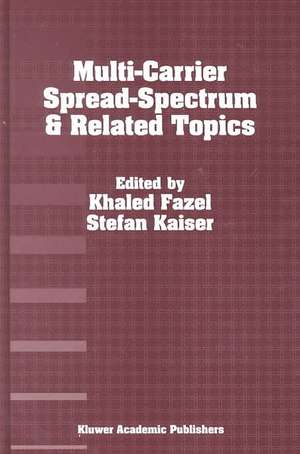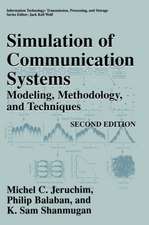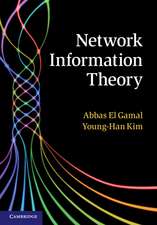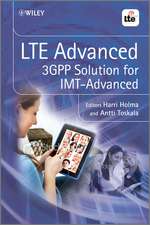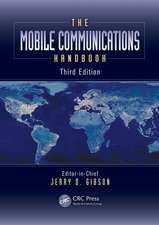Multi-Carrier Spread Spectrum & Related Topics
Editat de Khaled Fazel, S. Kaiseren Limba Engleză Hardback – 30 dec 1999
| Toate formatele și edițiile | Preț | Express |
|---|---|---|
| Paperback (1) | 1220.88 lei 6-8 săpt. | |
| Springer Us – 11 oct 2012 | 1220.88 lei 6-8 săpt. | |
| Hardback (1) | 1243.78 lei 6-8 săpt. | |
| Springer Us – 30 dec 1999 | 1243.78 lei 6-8 săpt. |
Preț: 1243.78 lei
Preț vechi: 1516.80 lei
-18% Nou
Puncte Express: 1866
Preț estimativ în valută:
237.99€ • 249.15$ • 196.93£
237.99€ • 249.15$ • 196.93£
Carte tipărită la comandă
Livrare economică 05-19 aprilie
Preluare comenzi: 021 569.72.76
Specificații
ISBN-13: 9780792377405
ISBN-10: 0792377400
Pagini: 360
Ilustrații: XVII, 360 p.
Dimensiuni: 155 x 235 x 26 mm
Greutate: 1.19 kg
Ediția:2000
Editura: Springer Us
Colecția Springer
Locul publicării:New York, NY, United States
ISBN-10: 0792377400
Pagini: 360
Ilustrații: XVII, 360 p.
Dimensiuni: 155 x 235 x 26 mm
Greutate: 1.19 kg
Ediția:2000
Editura: Springer Us
Colecția Springer
Locul publicării:New York, NY, United States
Public țintă
ResearchDescriere
Khaled Fazel Stefan Kaiser Digital Microwave Systems German Aerospace Center (DLR) Bosch Telecom GmbH Institute for Communications Technology D-71522 Backnang, Germany D-82234 Wessling, Germany In this last decade of this millennium the technique of multi-carrier transmission for wireless broadband multimedia applications has been receiving wide interests. Its first great success was in 1990 as it was selected in the European Digital Audio Broadcasting (DAB) standard. Its further prominent successes were in 1995 and 1998 as it was selected as modulation scheme in the European Digital Video Broadcasting (DVB-T) and in three broadband wireless indoor standards, namely ETSI-Hiperlan-II, American IEEE-802. 11 and Japanese MMAC, respectively. The benefits and success of multi-carrier (MC) modulation in one side and the flexibility offered by spread spectrum (SS) technique in other hand motivated many researchers to investigate the combination of both techniques, known as multi-carrier spread-spectrum (MC-SS). This combination benefits from the main advantages of both systems and offers high flexibility, high spectral efficiency, simple detection strategies, narrow band interference rejection capability, etc. . The basic principle of this combination is straightforward: The spreading is performed as direct SS (DS-SS) but instead of transmitting the chips over a single sequence carrier, several sub-carriers could be employed. As depicted in Figure 1, after spreading with assigned user specific code of processing gain G the frequency mapping and multi-carrier modulation is applied. In the receiver side after multi-carrier demodulation and frequency de-mapping, the corresponding detection algorithm will be performed.
Cuprins
Editorial Introduction. Acknowledgements. I: General Issues of Multi-Carrier Spread-Spectrum & Related Topics. Some Novel Concepts in Multiplexing and Multiple Access; H. Sari, et al. Wideband Multimedia Solution using Hybrid CDMA/OFDMA/SFH Techniques; M. Jankiraman, R. Prasad. Generalised Multicarrier CDMA for Wireless MUI/ISI-Resilient Uplink Transmissions Irrespective of Frequency Selective Multipath; G.B. Giannakis, et al. Performance Tradeoffs in Asynchronous Spread Spectrum Multi-Carrier Multiple-Access; S. Kaiser, et al. II: Applications of Multi-Carrier Spread-Spectrum & Related Topics. Performance of a Flexible Form of MC-CDMA in a Cellular System; H. Steendam, H. Moeneclaey. A Multi-Carrier Spread-Spectrum Approach to Broadband Underwater Acoustic Communications; R.F. Ormondroyd, et al. A New Combined OFDM-CDMA Approach for Cellular Mobile Communications; L. Ping. A Digital Microwave Point-to-Multi-Point (PMP) System Based on Multi-Carrier FDMA-Transmission; K. Fazel, V. Engels. A Hybrid TDMA/CDMA System Based on Filtered Multitone Modulation for Upstream Transmission in HFC Networks; G. Cherubini. III: Coding and Modulation. On Coding and Spreading for MC-CDMA; J. Lindner. MCM-DSSS with DPSK Modulation and Equal Gain Combining in Delay and Doppler-Spread Rician Fading; R.E. Ziemer, T.B. Welch. Influence of Code Selection on the Performance of a Multi-Carrier Spread-Spectrum System; J. Kühne, et al. Complex Valued Block Codes for OFDM-CDMA Application; A. Dekorsy, K.-D. Kammeyer. Two-Dimensional Differential Demodulation of OFDM Frames; E. Haas, S. Kaiser. Block Turbo Coding in OFDM-based HIPERLAN/2 Systems; R.G. Maynou, et al. The Performance Analysis of Multi-Carrier CDMASystems Using Different Spreading Codes in Frequency Selective Fading Environments; H. Xing, et al. IV: Detection and Multiplexing. Each Carrier Transmission Power Control with Antenna-Carrier Diversity for OFDM-DS-CDMA; S.P.W. Jarot, M. Nakagawa. A Wavelet-based Multicarrier Spread Spectrum System with Constant Power; S. Attallah, T.J. Lim. A Subspace Method for Blind Channel Identification in Multi-Carrier CDMA Systems; D.I. Iglesia, et al. Multiuser Detection with Iterated Channel Estimation; A. Lampe, C. Windpassinger. MUD Improvement by using Hexagonal Pilot Distributions for Channel Acquisition and Tracking in MC-CDMA Systems; F. Bader, et al. Adaptive Multi-Shot Multiuser Detection for Asynchronous MC-CDMA Using Bootstrap Algorithm; P. Zong, et al. V: Interfrence Cancellation. Blind Adaptive Interference Cancellation for Multicarrier Modulated Systems; M.A. Visser, Y. Bar-Ness. Performance of Downlink MC-CDMA with Simple Interference Cancellation; H. Ochiati, H. Imai. Wideband and Narrowband Interference Cancellation for Asynchronous MC-CDMA; A.C. McCormick, et al. Multiple Access Interference Cancellation in Multicarrier CDMA Systems Using a Subspace Projection Technique; D.I. Iglesia, et al. Interference Cancellation for a Multi-Carrier Spread-Spectrum FCDMA System; A. Nahler, et al. Narrowband Interference Mitigation in OFDM-based WLANs; R. Ness, et al. Multi-Carrier CDMA using Interference Cancellation; J.-Y. Baudais, et al. VI: Synchronization and Channel Estimation. An Overview of MC-CDMA Synchronization Sensitivity; H. Steendam, M. Moeneclaey. Blind Frequency Offset/Symbol Timing/Symbol Period Estimation and Subcarrier Recovery for OFDM Signals i
Notă biografică
Stefan Kaiser was the first researcher to address the institutional and legal aspects of the future air navigation systems in a pioneering thesis presented to the Institute of Air and Space Law, McGill University.
